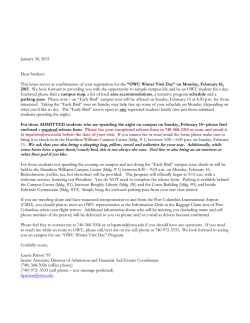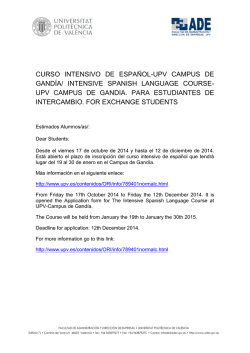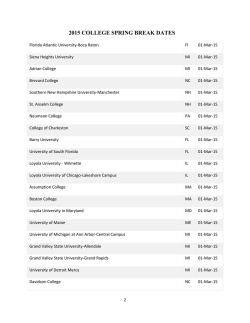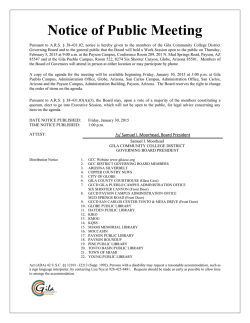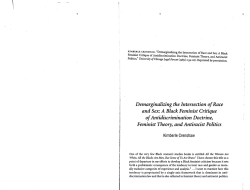
The Legacy of Campus Rape - Virginia Sole
THE LEGACY OF CAMPUS R APE S E XUA L ASSAU LT AT C O L L EG E S I S N’ T N E W. A N D I T’S N OT A B O U T YO U N G WO M E N W H O B I N G E D R I N K O R W E A R T I G H T C LOT H I N G. H E R E , A P RO M I N E N T F E M I N I ST E XA M I N E S T H E P H E N O M E N O N —A N D SU RV I VO RS O F A L L AG E S R E V E A L H OW A N AT TAC K C H A N G E D T H E I R L I V E S E S S AY B Y J E N N I F E R B A U M GA R D N E R N A R R AT I V E S B Y V I R G I N I A S O L E - S M I T H P H O T O G R A P H E D B Y J O C E LY N L E E J U L I E T T E G R I M M E T T , 38 ” I N E V E R T H O U G H T T H I S C O U L D H A P P E N TO M E .” “FOR YEARS, going to the gynecologist was awful,” says Grimmett. “It was consensual, and the school found him responsible not for rape but for violating the honor code. His penalty was one year of social probation. “He could still go to class, play sports, live in the dorm and walk by me in the hall,” Grimmett says. “The rape itself was horrific. But being treated like I didn’t matter by this institution—that’s what I still struggle to make peace with day to day.” That effort is what inspires Grimmett’s work. She now lives in Raleigh, North Carolina, and trains universities in how to respond to campus rape. And her sons, ages five and two, gave Grimmett another way to fight back. “What greater social justice can I do to prevent violence,” she says, “than to raise two loving boys?” didn’t matter how nice they were or how quick—I did not want them to touch me.” It brought her back to the night in 1995, her freshman year at Skidmore College, when she was sexually assaulted by a classmate in her dorm room after an evening of hanging out with friends. “I said every version of no, please stop. It went on for over an hour.” Afterward, Grimmett didn’t know where to turn or how to report the assault. “I’d always thought of myself as having a powerful voice,” she says now. “Suddenly, I didn’t want to tell anyone what had happened to me.” When she did speak out, the college arranged an administrative hearing. The perpetrator claimed the sexual contact 113 MORE FEBRUARY 2015 M Wisconsin. The Clery Act of 1990 mandated that schools publish their crime statistics, but sexual assaults reported by Lawrence amounted to just two or three; meanwhile, I alone had heard of dozens. Inspired by students at Brown University, my friends and I anonymously published a “castration list”—the names of male students who had raped women we knew—and hung it in the bathroom in the student union. In the end, we didn’t change much, but protesting the injustice and expressing rage felt good, felt important. 114 MORE FEBRUARY 2015 i n the years since I finished college, productions of The Vagina Monologues and the movement it inspired, V-Day, have raised more than $100 million in funds (and untold amounts of consciousness), and chapters of SAFER (Students Active for Ending Rape) have empowered students to understand and reform sexual assault policies on more than 40 campuses. Student organizers and feminist professors have laid the groundwork for what is happening right now: the most intense scrutiny of sexual assault and campus life since 1985, when Ms. magazine published the first national study of campus rape. That study popularized the terms acquaintance rape and date rape as well as the statistic (derived from the study) that one in four women is the victim of rape or attempted rape. Most of the new energy stems from Title IX, the 1972 law that says no school shall discriminate on the basis of sex. The National Collegiate Athletic Association was the first entity to fight for an exception from Title IX, cementing the sports element of the law in the public consciousness, but the amendment covers all aspects of education. A school cannot condone an environment that is hostile to women—and doing nothing about c ampus-rape culture is certainly hostile. Still, it wasn’t until 2010, when Delta Kappa Epsilon fraternity brothers at Yale University stood outside the freshman women’s dorms and chanted “No means yes; yes means anal!” that the protections of Title IX were brought to bear on campus rape. In 2011, Diane Rosenfeld, who is now a lecturer and the director of the Gender Violence Program at Harvard Law School, represented 16 current and former students from Yale in a Title IX complaint against the school. The legal action ended with an agreement that Yale would overhaul the way it deals with complaints of sexual misconduct. “Schools used to be worried they’d be sued by a guy accused of rape; now they are actually concerned about victims,” Rosenfeld says. “They rightfully want to avoid a civil rights investigation which could result in the school losing federal funding.” Then, on January 22, 2014, President Obama announced the establishment of the White House Task Force to Protect Students from Sexual Assault, which, among other advances, supplies technical and policy support to student PHOTO ON PAGE 112: KATE IN BED, MAINE, 2014 Y O LD E R S I STE R was raped at a high school party, the first time she tried alcohol. She drank too much too quickly, felt woozy and went into a bedroom to lie down. A guy she knew followed her in and proceeded to have sex with her. She was 14, and a virgin. Although it made no logical sense, overnight her reputation went from painfully shy, viola-playing, straight-A student to wanton slut. Other girls shunned her and wrote epithets on her locker; boys preyed on her. At parties, guys would push her into bedrooms or put their hands up her shirt as she walked by. Virtually no one stood up for her or questioned why what happened should be seen as her fault. No one used the word rape. As she described it to me many years later, being assaulted was horrible, but the aftermath—the scapegoating, the shunning, the “slutting”—was worse. It wasn’t until we went to college, in the late ’80s and early ’90s, that my sister and I began to make W H AT YO U sense of her experience. We suddenly had access CA N D O to feminism in the form of women’s studies classes, books like Susan Brownmiller’s Against Our Will, Take Back the Night marches and rape hotlines. Women of college Crucially, we were surrounded by women who had age are four times as been raped and who shared their stories. likely to be sexually Things were better than they’d been pre-1980s, assaulted as any when date rape hadn’t even become a term, much other age group. Raise less declared an injustice—when you could be your voice and: gang-raped on campus and not a single college EDUCATE Take the official was willing to hear about it. Or when you pledge and join the could report being raped by a man in a ski mask in White House’s “It’s on your dorm bathroom and the police officer would Us” campaign to raise ask why you were showering at night. Still, the awareness of campus situation was absurdly bad. In 1988, my freshman rape at itsonus.org. year at college, one of my friends was raped at a ACTIVATE Support stuparty and became pregnant; she dropped out, dent activism and learn had the baby and changed schools, keeping mum to mobilize a campus about the whole experience for many years. Two at cultureofrespect.org. women in my dorm were raped by the same inLEGISLATE Tell Conternational student. At another party, a woman I gress members that knew was trapped in a bathroom by her “friend” you want them to vote and not allowed out until she gave him a blow job. for the Campus AcI was aflame (in my crazy, conflicted, collegecountability and Safety feminist way) with an urgent need to change Act, which will require things. I fought with the philosophy majors at colleges to designate frat parties about their claim that rape was “natconfidential advisers to ural.” I scheduled meetings with deans where I help rape victims and angrily accused them of not caring about student stiffen the penalties for safety and covering up the “real” rape statistics Title IX violations. —V.S.S. at my college, Lawrence University, in Appleton, P ROT ECT YO U R DAU G H T E RS, P ROT ECT YO U RS E L F Ending campus rape means changing our thinking, our laws and our culture of violence. While we’re working toward that future, we want our daughters to be able to call for help during an assault if at all possible. Some of these apps could even be downloaded mid-party: activists. It was the first time a sitting president used his bully pulpit to decry campus rape. And in September, Obama launched “It’s on Us,” an awareness campaign that asks men and women to make a personal commitment to end campus sexual assault. Today there is an unprecedented convergence of presidential attention, government pressure and student activism. Women have tweeted and Facebooked their attackers’ names, described their experiences in open letters that have gone viral and created websites to chronicle horror stories of enduring the campus judicial process (see @RapedAtTufts). Thanks to social media, antirape activists have historic levels of visibility, and at this writing, 90 schools are being investigated for Title IX noncompliance. a re schools the best place to seek justice in these cases? Rape is a felony, so ONWATCH Lets the user one might think a victim would be best call friends or 911 with served by reporting it to local police two taps. She can set a rather than to a dean. “But when I went with stutimer if she’s in a vulnerdents to the district attorney, prosecutors wouldn’t able situation; if she take the cases,” says Susan Marine, who was the doesn’t enter her code founding director of Harvard’s Office of Sexual when the timer goes off, Assault Prevention and Response. “People say that the app alerts the cops colleges should get out of the business of adjudi($9.99 a year; on cating rape, but in many cases, especially cases of watchoncampus.com). acquaintance rape, the student judicial process is a victim’s only chance for justice.” CIRCLE OF 6 Lets the user Of the rapes that are reported to law enforceeasily contact friends ment, only 7 to 27 percent are ever prosecuted, acfor a ride, to check in or cording to an in-depth analysis by End Violence to signal an emergency Against Women International. Rapes that don’t fit (free; circleof6app.com). what the study authors call “the cultural stereoSAFETREK Hold down type of ‘real rape’ ” (which they define as rape by a the “safe button” on the stranger, involving a weapon and physical injury phone; when the button to the victim) are particularly unlikely to result in is released, the app dials arrest. And attacks on college students often don’t the police. Cancel the fit that stereotype. A student may have been drinkalert with a four-digit PIN ing, she is likely to have been raped by someone she ($1.99; safetrekapp.com). knows, and she may have had some degree of conMY FORCE One tap sensual sexual contact with her rapist. sends the phone’s GPS Schools are obligated to enforce the civil rights coordinates to a 24/7 live provisions of Title IX, which guarantee an education team that contacts auin an environment that is not sexually hostile, and thorities ($99 per year they can impose a range of sanctions on a student with code MYFORCE99; found responsible for sexual misconduct: They can myforce.com). —V.S.S. expel that student, suspend him, move him to another dormitory or change his classes. Schools also must respect the rights of a student after she has reported an assault, including not retraumatizing her with a bumbling or discouraging response. Legally, a student who has been raped is entitled to report it to the police. She also has the right not to report it to the police. Whether or not she makes a report, she is entitled to accommodations so that she and the accused are no longer in class or in a living situation together. Finally, the campus judiciary C O N T I N U E D O N PAG E 1 3 4 115 MORE FEBRUARY 2015 YO U CA N R E P O RT A R A P E E V E N D ECA D E S L AT E R Only 12 percent of college-age victims ever report their assault to the police, according to the Department of Justice. If you or someone you know was raped on campus years ago, you may think there’s nothing you can do now. But that’s not true. “There are many important reasons to report a rape, no matter when it happened,” says Katie Koestner, executive director of Take Back the Night (TBTN). She notes that the average rapist will assault 12 to 17 women before going to prison. “There may be a whole trail of victims after you,” she says. “Notifying the authorities can help make a conviction in those cases even if the statute of limitations is up on yours.” Reporting your rape now can also provide a powerful sense of closure. Several women contacted by More for this story decided to report campus rapes that had happened decades earlier. Here’s how to do it: FIND THE STATUTE OF LIMITATIONS IN THE STATE WHERE THE ATTACK OCCURRED by visiting rainn .org/public-policy/laws-in-your-state. Criminal prosecution may still be possible, especially if the attack occurred before you turned 16. REPORT TO THE CRIMINAL SYSTEM. Even if the criminal statute of limitations has expired, contact the police department in the town where the rape occurred and ask to speak to the special-victims unit or the officer who handles “sensitive crimes.” He or she will walk you through the reporting process. If your rapist has moved away, you can also report the crime to the police department in the town where he lives now. “They won’t be able to prosecute, since the attack happened out of their district, but if he rapes again, they’ll have your story on file,” Koestner says. REPORT TO THE CIVIL SYSTEM. If you no longer are able to pursue criminal charges, you may still be able to sue for damages in civil court. TBTN offers free legal advice to survivors; click on “Request Legal Assistance” at takebackthenight.org/ get-help/ to get a response within 24 hours. REPORT TO YOUR CAMPUS. “Schools need to know this has been happening for a long time,” Koestner says. “Many colleges don’t recognize the statute of limitations—so if he’s employed by the school or in any way affiliated as an alum, they can still hold a hearing.” Your report will have more weight if it comes with a lawyer attached; the TBTN legal team can guide you through this process as well. —V.S.S. » J E N N I F E R DIC K E R S O N , 3 5 ” T I M E . T H AT ’ S T H E O N LY T H I N G T HAT M AK E S I T B E T T E R .” from chronic anxiety. “I don’t trust anybody. I was raped by someone I knew—but that just made me more scared of people I don’t know.” For years, that meant grocery shopping at 2 am to avoid crowds and only going to restaurants where she could sit with her back against the wall. Dickerson also got involved in an abusive relationship soon after the rape; it was three years before she felt able to leave. “It was easy for him to control me, because I already felt like I wasn’t worth anything,” she recalls. Today she is living in Colorado Springs, happily married with three children, and still trying to come to grips with her fear. “It’s a work in progress,” she says. “My life is completely different. But I can’t let what happened control me. I know now that I deserve to be happy.” “EVEN now, 17 years later, when my kids hug me, there’s a second where I have to fight off panic,” says Dickerson. “Because he choked me while he raped me. For three hours.” The assault happened in 1998, during Dickerson’s sophomore year at Southwest Texas University; a male friend attacked her in his dorm room after a night of watching baseball and eating pizza. She told a campus police officer the next day but didn’t officially report the rape to her college. “I was terrified in case they ruled against me, because I had to see him in class,” she says. By the time she decided to go on the record, the student had withdrawn from school. “I never saw him again, but I’ve needed drugs to function ever since,” says Dickerson, who suffers 116 MORE FEBRUARY 2015 L OR E T TA ROS S , 6 1 ” I V I S I T E D M Y T R A U M A O N M Y B O DY. I T WAS S U I C I D E T H R O U G H C I G A R E T T E S A N D F O O D.” ROSS was raped three times before she turned 17; the attacks included incest that resulted in the birth of her son when she was just 15 and a gang rape that she says occurred in an off-campus apartment during her freshman year at Howard University. Ross never knew the names of her assailants. “I was so afraid of men,” she says. “For a long time, I even thought I was becoming a lesbian. I did not want to be heterosexual.” For years she didn’t speak out about any of the attacks, including the one near Howard. “This was 1970; it didn’t seem to me that there was any way to report it or to hold these people accountable,” she says. “It never occurred to me to call the police because I assumed I would be blamed for going to the party.” She eventually started using drugs, relying on them to block out the trauma. Then, in 1979, she became the director of one of the country’s first rape crisis centers—and found herself unable to work the call-in hotline because she had not yet dealt with her own past. A colleague helped her find a therapist, and Ross quit using drugs. “I’ve been clean and sober since 1982,” she says. “But I don’t ever feel like I’ve healed.” Ross, who now lives in Atlanta, has dedicated her career to reproductive justice and human rights; in 2004, she served as codirector of the March for Women’s Lives, one of the largest protest marches in U.S. history. “That rape crisis center is where I became a feminist,” Ross says. “Turning pain into activism should happen more often.” 117 MORE FEBRUARY 2015 D O N N A L . P OT T S , 5 2 ” I W O R R Y A B OU T M Y DA U G H T E R . I D O N ’ T WAN T A N YO N E TO P R E Y ON H E R . S H E ’ S A LOT L I K E M E .” AN ENGLISH professor in Pullman, Washington, Potts engages her students by moving around the room as she teaches. But she’s had to force herself to do that; for almost 20 years, she hid behind her lectern in every class. “I needed to conceal my body to feel safe,” she says. Potts developed that protective instinct soon after she was raped in 1981, during her first year at the University of Missouri, by one of her professors. “My father had just committed suicide, and the professor invited me over, ostensibly to console me,” she recalls. “The last thing he did before he raped me was to show me his daughter’s room.” The professor warned Potts not to tell anyone, but she says she disclosed the attack to a university psychiatrist. “His only reaction was, ‘Well, I bet a lot of men are attracted to you.’ No one suggested that it was a crime. I struggled to even use the word rape for a long time.” Potts battled depression off and on for 30 years until she joined Pandora’s Aquarium, an online support group. “My mother never accepted what happened; my oldest friend didn’t believe me,” says Potts. “I didn’t have anyone to talk to who understood until I found other survivors.” Now she pays it forward, serving as a moderator on the site and teaching courses on trauma in literature. “I spoke with a student who was raped on our campus recently, and she told me I was the first survivor she’s ever met,” Potts says. “In some ways, not nearly enough about rape culture has changed.” 118 MORE FEBRUARY 2015 K AT I E KO E S T N E R , 4 2 ” I ’ M N OT E M BA R R A S S E D. D ON ’ T T R E AT M E S E N S I T I V E LY. H E WAS W R O N G .” KOESTNER was attacked in 1990, after a dinner date during her freshman year at the College of William & Mary. “I was raised with conservative Christian values about waiting until marriage,” she says. “I was a virgin and suddenly I wasn’t a virgin anymore—and it happened without my consent, with me pushed up against a cinder block wall.” Koestner reported the attack to the dean’s office and the campus police. The district attorney never pressed charges, but the university held a hearing; it found the accused guilty of sexual assault and banned him from her dormitory for the rest of the semester. He wrote a letter to the school newspaper claiming he’d been “wrongly branded as a date rapist” and the sex was consensual, and many students rallied around him. “I was the subject of a 2,000-person petition saying I lied,” Koestner recalls. “I was ostracized, my car was vandalized, but all of that made me strong and fearless. So it is what it is.” Koestner dropped her studies in chemical engineering for a women’s studies–public policy double major and threw herself into antirape activism; she is now executive director of Take Back the Night. “I had to rethink everything I was ever told I had to do to get life right. Because now I knew what it was like to not have any power,” says Koestner, who lives in Pennsylvania. “It took a long time for me to trust anyone.” Today she thanks her husband for helping her readjust her view of the world. “Now,” she says, “I believe that everyone is capable of change.” 119 MORE FEBRUARY 2015 T H E L EGACY O F CA M P U S R A P E process must be clear, timely and fair. Says Alexandra Brodsky, a Yale Law School student and the founder of Know Your IX: “Title IX promises women and survivors that this is our campus, too.” C ON T I N U E D F R O M PAG E 115 u sing Title IX as a tool to force colleges to pay attention to this issue is the best option we have right now. But as a journalist and filmmaker who has spent more than a decade interviewing women and men about their sexual assaults, I believe that the Title IX movement will become just another flurry of regulations if we don’t fundamentally change our rape culture: the ways in which we all participate in misogyny and domination, such as the practice of slutting—turning women into scapegoats to whom one can do anything and it’s their fault. My 2013 documentary, It Was Rape, is a staple of many sexual assault sensitization programs, and after screenings I typically hear from dozens of women (and some men) of all ages about their own assaults. Some of the most valuable activism I’ve ever participated in is listening to someone as she reveals a part of herself that has long been exiled and telling her, “I’m so sorry that that happened to you.” It Was Rape ends with a professor who was raped at a party her freshman year thinking about what she would say to her attacker if she could talk to him now. “I would ask him if he’s strong enough,” she says, “like I believe I am, to join this movement to end sexual violence—because he wants the world to be better for women and men.” JENNIFER BAUMGARDNER is the director of It Was Rape; the author of Manifesta, Look Both Ways and Abortion & Life, among other books; and the executive director of the Feminist Press, which is helping produce the StopSlut movement (stopslut.org) to transform rape culture. @jenniferbedbaum SURVEY RULES NO PURCHASE OR SURVEY PARTICIPATION IS NECESSARY TO ENTER OR WIN. Subject to Official Rules at www.surveygizmo.com/ s3/989068/Sweepstakes-Rules. The $10,000 Reader Survey Sweepstakes begins at 12:00 am ET on October 1, 2014, and ends at 11:59 pm ET on September 30, 2015. Open to legal residents of the 50 United States and the District of Columbia, 21 years or older. Sweepstakes is offered by Meredith Corporation and may be promoted by many of its publications in various creative executions online and in print. Limit one (1) entry per person and per email address, per survey. Void where prohibited. Sponsor: Meredith Corporation. 134 MORE FEBRUARY 2015
© Copyright 2024

